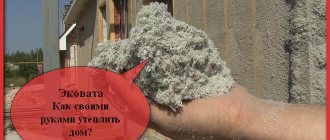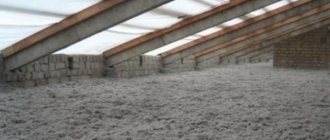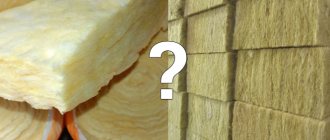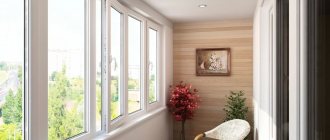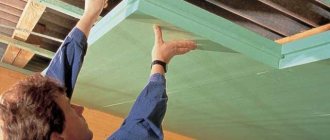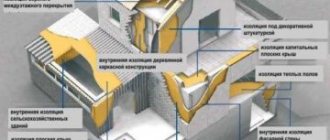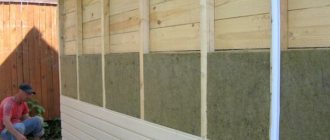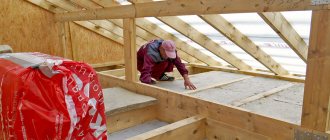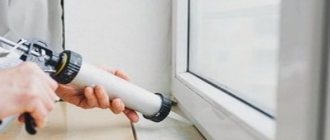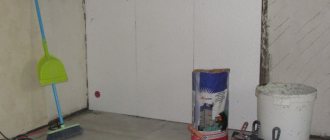Home› Services› Floor insulation
Floor insulation technology: dry method (open laying).
Recommended insulation thickness:
- floor, ceilings - 150-200mm; non-residential attic - 300-400mm; attic - 300-400mm;
Insulation density: ~35kg/m3.
Insulation technology:
The recommended design is described at the link: proper insulation of the attic
When insulating open horizontal surfaces, such as floors and interfloor ceilings, the open laying method of ecowool is used. The insulation is evenly distributed over the surface from a hose, after which it is covered with the floor covering.
If open installation is not possible (a finished floor is laid), the insulation technology is similar to roof insulation. The only difference is that the surface is not inclined, but horizontal.
Insulating a cold attic
When insulating the attic, there is no need to cover the ecowool with anything.
There is also no need to remove old insulation when reconstructing an attic space. This is possible thanks to seamless insulation technology. Ecowool will fill all cavities and leave no voids.
As for the thickness of the insulation: we recommend a layer of at least 30 cm for a non-residential attic. This is due to the fact that warm air from throughout the house will rise upward and large heat losses will occur at the top point of the building. It is there that the heat must be reliably retained by the insulation.
You can read more about the process of insulating houses with Ecowool in the section Installation of Ecowool.
Examples of our work:
In many cases of individual house construction, it is possible and advisable to also build an attic. You may need it, for example, for your office, creative workshop, and in the summer your guests can relax in the attic. The cost of construction will not increase much, but the advantages are obvious.
- Review of ecowool materialPreparation for insulationMethods of ecowool insulation
Therefore, let's talk about how to insulate the attic, because this is the coldest part of the house in winter, and the hottest in summer.
Ecowool as the most effective insulation
Ecowool is a cellulose heat and sound insulating material that is widely used in both individual and industrial construction. Ecowool usually consists of 80% crushed newsprint, 12% borax and 8% antiseptic (boric acid is used as the latter).
The appearance of ecowool is unremarkable
All components of ecowool are absolutely harmless to humans (the common belief that newsprint contains printing lead is incorrect, since for many years newspapers have been printed exclusively using the offset method).
By the way, at the International Competition of Environmentally Safe Products, ecowool was included in the register of natural products and awarded the corresponding medal.
Why is it recommended to use ecowool for attic insulation?
Here the following advantages should be taken into account:
- ecowool ensures a seamless coating, which is of particular importance when insulating in places where the wall meets the roof of a house; ecowool has excellent soundproofing properties (for romantics who like to enjoy the sound of raindrops on the roof, please do not read this); ecowool protects the room well from overheating in summer season; ecowool does not require a vapor barrier, which is especially important for the attic floor, because the walls and ceiling of this room actively remove water vapor to the outside. As a result, ecowool most effectively regulates the relative humidity in the attic.
We recommend watching a voluminous and very detailed video about ecowool; you will find comparisons, prices, installation, and of course a full description of the material:
Drywall fastening technology
In some cases, the roof of the attic may well serve as the walls of the interior, since the slopes are located almost vertically. But very often the roof slopes are quite steep. In such cases, it makes sense to erect internal partitions in the attic so that the walls of the room are vertical and the ceiling is horizontal. Insulation is arranged along the roof slopes.
In some cases, the roof of the attic may well serve as the walls of the interior, since the slopes are located almost vertically.
You will have to construct partitions and a ceiling from plasterboard. The technology of this process is as follows:
- Attach wooden slats with a cross-section of at least 50*30 mm as a frame to the floor and rafter beams. Fasten with the help of screws and dowels, as well as metal plates. The pitch of the vertical posts is equal to the width of the drywall sheet.
- Sheathe the resulting wooden frame from the inside with sheets of plasterboard using self-tapping screws. Choose self-tapping screws with a length of 30 mm or more. The fastening pitch is at least 250 mm.
This design can also be used for lining.
Gypsum concrete partitions are constructed inside the attic so that the walls are vertical and the ceiling is horizontal.
Preparation for insulating the attic with ecowool
The source material is transported in compressed form, which is why the insulation process begins with “fluffing” the ecowool.
For this purpose, it is “loosened” in any suitable container: vat, trough, etc., using a conventional drill. Next, you should definitely check the condition of the rafters: if the supporting structure is not reliable enough, it should be strengthened.
To apply ecowool to the floor, you need to remove the flooring
The next preparatory stage is the installation of waterproofing of the laid roof of the house, while it is advisable to install air channels on the roof slopes in order to properly ventilate them. Then they begin to prepare the attic room itself: it is advisable that there is no floor covering in it (otherwise, before insulating it with ecowool, it will have to be temporarily removed). It is also necessary to thoroughly clean the room from dust, and install protective screens in places where electrical wiring is installed or where electrical appliances are located.
Mineral wool
The use of mineral wool has become popular due to such advantages of the material as:
- durability;
- good thermal insulation properties;
- high reliability;
- good moisture resistance.
Mineral wool
Basic data of mineral wool products are characterized according to a number of regulatory documents:
- GOST 9573-96;
- GOST 21880-94;
- GOST 22950-95.
Most modern manufacturers produce mineral wool according to their own specifications. However, these specifications meet more serious requirements than those previously included in GOST.
Mineral wool is an excellent thermal insulation material
Insulating an attic with mineral wool is not at all a difficult job. The process should begin with the roof, conducting a thorough inspection of the roof and removing any defects found. It should be remembered that the thickness of the attic insulation with mineral wool for the upper floors of structures, according to the standards, should be at least 150-200 mm.
It is imperative to take into account such a parameter as the thermal conductivity coefficient of the insulation, which is always displayed in the certificate for a particular material, otherwise the required thermal insulation effect will not be obtained.
Important! When working with mineral wool, be sure to use a respirator, gloves, goggles and protective clothing. This will protect the respiratory tract from small particles from this material.
Protective equipment - let's stay healthy!
Methods for laying ecowool
Three methods of insulation are used:
The dry backfill-ramming method. Its advantage is that this insulation technology can be implemented independently. The loosened ecowool is evenly laid out on the insulated surface, the consumption of ecowool is approximately 3 packs per 1 m2 of roofing, and the filling density must be at least 45 kg/m3. It should be noted that it is quite difficult to check the latter indicator in everyday conditions;
The method of wet-adhesive spraying, for the implementation of which it is advisable to invite specialists. The method is implemented using special blow molding equipment, and the density of the finished coating increases to 60 kg/m3 due to special treatment of ecowool with a water-based adhesive composition;
Dry blowing of ecowool using pneumatic transport
A dry blowing method that ensures insulation of all hard-to-reach areas of the roof. The popularity of this method lies in the fact that it provides optimal ratios of speed and quality of insulation, and the filling density reaches 70 kg/m3. For dry blowing, professionals are also invited, however, you can master it yourself, but you will have to rent the equipment necessary for this;
A combined insulation method in which the process takes place in two stages: the first layer is applied using the wet-glue spray method, and all underfilled volumes are blown in using the dry method.
Regardless of the method, the optimal thickness of the insulation layer is 20…30 cm.
Do-it-yourself insulation of the attic, as well as insulation of the roof from the inside, will allow you not only to save on heating in the future, but will also guarantee an optimal microclimate inside the room.
Complex thermal insulation of the attic
In this article we will figure out how to properly insulate an attic with your own hands, what technology for insulating gables, floors and ceilings, and what materials are best used for this.
Recommendations from professionals ↑
- If the distance between the ridge and the attic ceiling is more than 80 cm, this allows work to be carried out through the attic room.
- Insulation can also be applied from the ceiling side, using technological holes in the inner lining.
- If the distance between the ridge and the attic ceiling is too small to carry out the work, installation is carried out using technological holes in the inner lining, from the ceiling side.
- The chimney exit to the roof is carried out taking into account the fact that ecowool will begin to smolder at high temperatures.
© 2022 stylekrov.ru
1Why do you need to insulate the attic?
One of the most important stages in converting an attic into a full-fledged attic is the thermal insulation of the roof, walls and floor of the room.
The question of creating an attic, in most cases, arises when there is an acute lack of free space in an already used house. Therefore, the attic, basically, has to be equipped from a room that was not originally designed for use for year-round living.
The starting point is an ordinary attic, as when insulating a roof along the rafters, the roof of which is a rafter system made of wooden beams, lined with slate or tiles.
In addition to the lack of thermal insulation properties, the roof of the house is characterized by multiple micro-gaps and holes through which drafts can easily pass, and, in very advanced cases, precipitation can leak.
The lack of monolithicity of the roof structure is fraught with the fact that it is unlikely that it will be possible to properly warm up the attic furnished from the attic even when using a very powerful heating system, since the heat loss from the room will be colossal.
Insulating the attic floor (gables, ceiling and floor) eliminates all of the above problems. The insulated attic will turn into a room comfortable for year-round living. Insulation guarantees an optimal indoor microclimate.
You will be able to maintain the desired temperature without any problems, since in winter the thermal insulation will prevent heat exchange between the warm air inside the attic and the frozen roof and cold air outside, and in the summer it will protect the room from heating up under the influence of sunlight.
Installation of waterproofing film on the attic roof
A thermally insulated attic, as well as insulating the ceiling of a cold attic with mineral wool, provides enormous space for maneuver - it can be equipped with a full-fledged living space, a recreation area for children, or functional rooms - a workshop, a bathroom, a study or a library.
1.1What is “correct” insulation?
The technology of complex thermal insulation of the attic involves the use of not only insulation materials - materials with low thermal conductivity, but also additional waterproofing and vapor barriers that will protect the room from precipitation and any drafts penetrating from the outside through the roof.
It is worth understanding that such multi-layer insulation will certainly take up some amount of free space, but not everything is so scary - properly thought-out thermal insulation, the thickness of the insulation in which does not exceed the thickness of the load-bearing rafters, will “eat up” space equal only to the thickness of the decorative cladding, since the the insulation will be recessed between the rafter frame.
The first layer when insulating the roof, to which maximum attention is paid in the do-it-yourself attic thermal insulation technology, since it is through the roof that maximum heat loss occurs, is the waterproofing layer.
For this, special waterproofing films are used, as when insulating the roof of a house with your own hands, which tend to allow steam to pass through, but prevent the penetration of water. Such films reliably protect the insulation from any precipitation that has penetrated through the roof of the house, and allow the condensation formed on it to evaporate.
The second layer is the insulation itself - a material with low thermal conductivity, which is a barrier that prevents heat exchange between the warm air inside the attic and the cold air outside.
Scheme of proper attic insulation
Next comes a vapor barrier film, which protects the insulation from the formation of condensation due to air humidity and temperature changes. And our “sandwich” is completed by cladding, which can be made from any decorative material - plasterboard, OSB, chipboards.
1.2 Requirements for attic insulation
Since they resort to arranging an attic in a house where it is necessary to create additional free space, it is very important to use this free space as rationally as possible.
Insulation of the gable using insulation for the roof, ceiling and floor of the attic with your own hands must be done using materials with low thermal conductivity in the range of 0.03-0.04 W/mk, which allows you to obtain effective thermal insulation with a minimum thickness of insulation.
When choosing the thickness of the material, proceed from the fact that it should not be greater than the length of the rafters, since the heat insulator recessed between the beams makes it possible to attach the sheathing directly to the rafters, which further saves free space.
It is also recommended to give preference to materials that, in addition to low thermal conductivity, have good sound insulation properties. The roof of the house itself, as a rule, is made of slate or tiles - materials that practically do not suppress sounds, so additional soundproofing of the attic will not be superfluous.
When choosing the best way to insulate your attic, try to avoid flammable materials. Fire resistance is an important factor due to the fact that the attic structure itself consists almost entirely of wooden elements. This requires responsibility in addressing the issue of fire safety.
Thermal insulation of attic floor joists
2Review of the best materials
Based on the above requirements, we can conclude that for do-it-yourself attic insulation, three types of heat insulators are best suited
- Insulation based on mineral wool (excellent insulation of the attic of a private house); Ecowool (cellulose insulation); Insulation made from extruded polystyrene foam;
These materials are from approximately the same price category, but each of them has certain advantages and disadvantages that must be taken into account when choosing.
It is worth saying that do-it-yourself attic insulation can also be done using budget materials, the same polystyrene foam, which is excellent for thermal insulation on the outside of the gable, or for insulating a joist floor.
In general, the best option for insulating the attic ceiling is mineral wool. This is a lightweight material with low thermal conductivity (about 0.035 W/mk), low hydrophobicity (the percentage of absorption when completely immersed in water for 24 hours is 1% of the volume of insulation), and durability.
Insulating the attic with ecowool (not to be confused with mineral wool), a loose cellulose insulation material, is an excellent option for floor insulation. You won’t be able to apply ecowool on vertical and sloped surfaces with your own hands, since special equipment is required, but the thermal insulation of a log floor with this material is carried out using improvised means without any problems.
Roof insulation with mineral wool
Briefly about the main thing
The very name of ecowool hints that it is an environmentally friendly and harmless insulation material. In fact, one can argue with this statement, as well as with the fact that this is one of the cheapest and most effective thermal insulation materials.
But when compared with expanded polystyrene or mineral wool, it actually has many impressive advantages, in particular - excellent heat capacity, vapor permeability, resistance to harmful biological factors, and a high degree of sound insulation.
Disadvantages can be found in any material, the main thing is that they are not critical and can be leveled out by following the installation technology. In this regard, ecowool is a very worthy insulation material.
Read later
We will send the material by email
2.1 Insulation of the pediment outside the attic
We’ve sorted out the materials, now let’s look at how to properly insulate an attic in practice and insulate the roof using polyurethane foam.
It is recommended to insulate the outside of the pediment using slab insulation, since they do not require a supporting frame and can be attached to the surface of the pediment using glue.
- The surface of the pediment is cleaned of dirt; if there are oil stains on the material, they must be degreased with gasoline or acetone; The pediment is coated with a deep penetration primer, which is necessary for better adhesion of the adhesive mixture and the pediment; Along the lower contour of the pediment we mount a metal profile that will hold the first row of insulation; We dilute the adhesive mixture according to the manufacturer’s instructions. We evenly apply glue to the back surface of the slab insulation and install the thermal insulation from bottom to top; The top row of insulation must be adjusted in size so that the gap between it and the roof is minimal; The joints between the thermal insulation and the roof are sealed with polyurethane foam; The surface of the thermal insulation is covered with a moisture-repellent primer; Next is done plastering the insulated pediment using fiberglass reinforcement mesh; If desired, the plaster can be painted, or the pediments can be finished in any other way.
Safe wallpaper
Let's say that you decide not to buy vinyl wallpaper because you are not sure that you will be able to correctly choose the appropriate option. What alternative should I find for them?
Fiberglass wallpaper is safe and of high quality. Another option is expensive wallpaper made from safe materials, such as bamboo or cork. Well, or just take paper ones, they are not so strong and not so durable, but still, from a safety point of view, they definitely won’t let you down.
https://youtube.com/watch?v=g1H4iN9DUuk
2.2 Floor insulation
Thermal insulation of the floor can be carried out with any material that meets the requirements of thermal conductivity. The best option is insulation with mineral wool, polystyrene foam, or ecowool. When insulating an attic with ecowool, be prepared for the fact that the material will shrink by about 20%.
Installing a vapor barrier over insulation
Let's consider the simplest option for insulating the lag floor of an attic with mineral wool.
On the rough floor covering, a vapor barrier film is laid and secured.
We fasten the film with a stapler so that it fits tightly to the joists and cross boards; We lay insulation between the joists. When using roll or slab thermal insulation, the insulation must be adjusted in size so that it is in close contact with the joists, since the presence of cracks increases the overall thermal conductivity of the insulation; A second layer of vapor barrier film is rolled out and secured on top of the insulation. The film must be solid - the logs are covered together with the insulation; The front covering of the floor is installed from wooden boards.
Installation process
We have already managed to study the features and characteristics that environmentally friendly insulation materials have; it remains to consider the method of installing them on the surfaces being treated. The installation of rolls, slabs and mats made from plant components is no different from the installation of mineral wool.
Preparation
At the first stage, the surface is prepared by removing old sheathing and insulation elements. It is better to plaster large chips and defects.
It is also necessary to clean the walls from dirt and dust. Now you can begin the main work.
Lathing
For the best effect, it is necessary to install a slatted frame made of wooden planks or metal profiles on the external walls of the facade. The thickness of the sheathing should correspond to the thickness of the insulation. The step between the frame elements is marked taking into account the sizes of the slabs or insulation rolls.
Laying the material
Mats or slabs of vegetable insulation are placed tightly and without gaps between the guide rails, starting from the bottom. A cladding is installed on top of the insulation. If the attic space is being treated, the material is placed between the rafters.
2.3 Ceiling insulation
- We check the rafter system for defects, and if they are found, we replace or restore the damaged areas; Using a construction stapler, we attach a waterproofing film over the entire surface of the ceiling; We install insulation between the rafters. Mineral wool is a light but dense material; if the size is correctly adjusted, it will stay between the rafters without additional fastening, however, if necessary, metal staples can be used for fixation; We fix a vapor barrier film on top of the thermal insulation; We carry out cladding with decorative material - plasterboard, OSB, fiberboard, plywood.
2.4 DIY attic arrangement (video)
Nowadays, low-rise construction and frame wooden housing construction are developing rapidly. But the size of the plots and expensive land force us to take a thoughtful and thorough approach to the design of a residential building.
To increase the area of a functional home, the most successful solution would be to design a house with an attic room. But in the future, special attention should be paid to insulating the attic and taking into account its design features. Namely, that it does not have a “thermal cushion”.
The attic has more contact with the street than any other room in the house. And if the under-roof space is not insulated properly, then all the warm air will escape outside.
In this regard, it is necessary to thoroughly approach the issue of thermal insulation. Unlike insulating an attic, in an attic it is necessary to insulate the floor, walls and roof. Another important feature is the need to insulate the inclined surface (This is at least two slopes.
At the same time, do not forget about the gables.). Often it is the insulation of the attic roof that causes the greatest difficulties. Therefore, it is necessary to approach the choice of insulation material wisely.
Previously, the choice was between several slab insulation materials presented on the Russian market. But now there is an alternative. Ecowool is a cellulose loose insulation material.
When insulating an attic, ecowool is placed in the interframe space. Insulation is carried out both at the construction stage and in a completely finished frame. The difference is that at the construction stage, installation can be done not only mechanized, but also manually during the gradual construction of the frame structure.
If the frame is already installed, then technological holes are made in it, and cotton wool is blown through them using a blowing machine. To do this, it is not necessary to involve specialists. All work can be done independently.
Useful tips
It is better to insulate the attic in spring or autumn. During the work, there should be enough space between the roof and the heat-insulating material for ventilation - an air gap. This will help protect surfaces from the formation of mold, rot, and fungus. The thickness of such a layer depends on the thickness of the material itself and its shape. To improve the tightness of the structure, the vapor barrier is overlapped, and then all joints are closed with tape.
When decorating a plasterboard ceiling in an attic room (provided the roof is finished), profiles are used. It is possible to perform thermal insulation of the gable after insulating the attic of the house (work is carried out from the outside). Before insulating floors, you need to make sure that they do not require additional reinforcement.
Even if all the work is done correctly, there is a risk of small condensation forming. Therefore, it is better to provide the structure with a double air cushion (for insulation). This will help maintain continuous air circulation and moisture removal.
The attic, warm on all sides, is perfect for winter living!
Watch the video below for tips on installing an attic.
